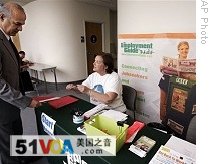Washington
02 July 2009
 |
| Unemployed worker (L) talks with Employment Guide staffer at job fair in San Jose, California 20 Jun 2009 |
Economists and U.S. officials had almost identical reactions to a Labor Department report that American employers cut 467,000 jobs in June.
"This month's [unemployment] report is a setback," said Jack Albin, chief investment officer at Chicago-based Harris Private Bank.
"This is certainly a setback," said Cristina Romer, who heads President Barack Obama's Council of Economic Advisors.
Both Ablin and Romer appeared on Bloomberg Television.
Last month's job cuts total exceeded most economists' expectations by more than 100,000. But the point-one percent jump in the unemployment rate from May was more modest than had been anticipated.
June's job cuts reversed a trend of lower month-by-month loses in the U.S. economy. May saw just more than 300,000 jobs eliminated, down sharply from more than 500,000 in April.
Although June's total was higher than the number recorded in May, both figures are significantly lower than job-loss totals recorded at the beginning of the year - a fact Romer was quick to point out.
"Back in December, January, February and March, we were losing close to 700,000 jobs a month," Romer said. "We have seen some diminution."
But even if the U.S. economy is losing jobs at a slower pace than half a year ago, the overall unemployment picture remains bleak, according to Stuart Hoffman, chief economist at PNC Financial Services Group.
"It is sort of like a bathtub," Hoffman said. "Maybe we have stopped the drain a little bit in terms of the people losing jobs. But what you really need is hiring, a faucet. And no one has turned on that faucet yet."
America's true unemployment rate may, in fact, be higher than the number provided by the Labor Department, which does not include people who searched for work in vain and have given up, or those who settled for part-time work. If both categories are added, the unemployment rate would top 16 percent, the highest number in 15 years.
Harris Private Bank's Jack Ablin says deep recessions generate a vicious circle between job losses and reduced economic activity.
"We have cost-cutting [by businesses] as a result of lower profits," Ablin said. "And that cost-cutting is resulting in higher unemployment, and of course the higher unemployment is creating lack of demand. And that is where the disappointments in profits come from."
Interrupting that cycle was a primary goal of President Obama's massive economic-stimulus package, which he championed almost immediately upon entering the White House. The idea was to boost spending, thereby creating demand for products, while reducing job losses. Administration officials say funds are flowing into the U.S. economy, but real job creation may not be seen until the beginning of next year.
On a more positive note, the U.S. Commerce Department reported a 1.2 percent boost in factory orders in May, the biggest jump in nearly a year.